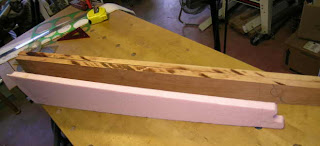

One of the tricky parts of this design is the pillar ending outside of the soundbox. For this to work the grain of the wood had to run front to back. However, construction for the Limerick says that it is important to have the direction running side to side. My solution is a laminate of wood added on the interior- going side to side. Think of it like a really thick plywood. Should be plenty strong. First I made the board by gluing a resawn piece of lumber, and then sanding it flat.


All the angles had to be matched in order to get a good fit. Then it had to be glued to the bottom in exactly the right place.

Sweet- this is just about as good as it could get. I'm proud.

I was looking forward to doing this little bit of turning. The dowel on which the neck rests is of ebony. I had some just the right size, so it just needed to be turned and finish sanded. I rounded the ends- carefully, using the big belt sander with a 60 grit belt- kinda like running it on a gravel road. Then I sanded it to 220 on the belt sander.

This may not look too good yet- but I know what I'm doing- or at least I hope so. No way to cut this out square, so I just cut each profile using a 1/8" Timberwolf blade on my 37 year old Craftsman band saw with each side flat to the table. Now I just need to even it out some.


Here are some of the tools- a very coarse rasp and a coarse, round micro-plane file. Between the two and a bit of sandpaper it came out great. Finessed the groove for the dowel by wrapping sandpaper around the dowel and using it to make it a super fit- gotta give hubby credit for that idea.


I haven't shown the soundboard and back board, but they are complete and ready to go in later on. Cutting and fitting took quite a while- but then I tapped on the boards while they were in place- and got a really great sound. A good omen for a great sounding harp- I hope.
Now I get to cut the neck and pillar out of 2" thick cherry boards.
Time: 13 hours Total: 73










































